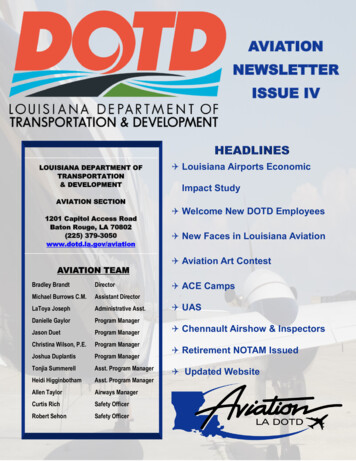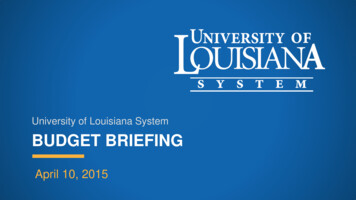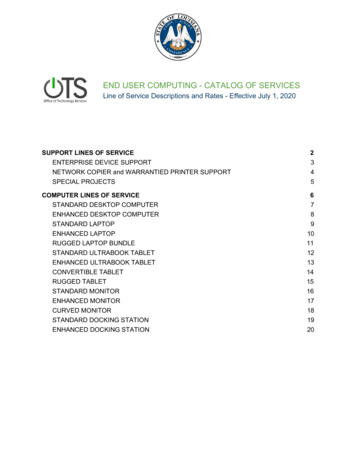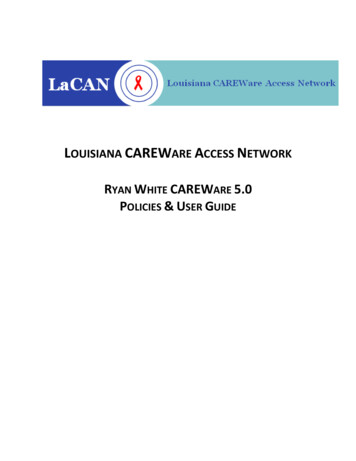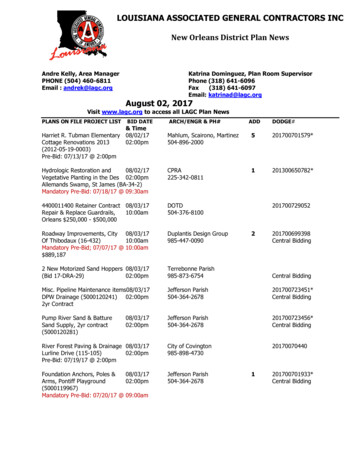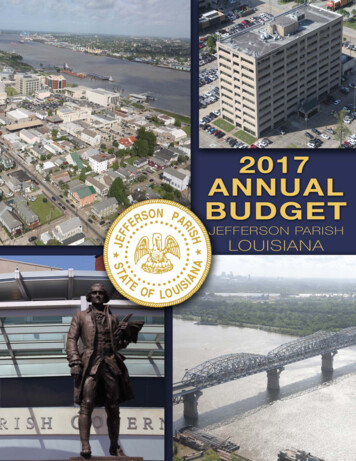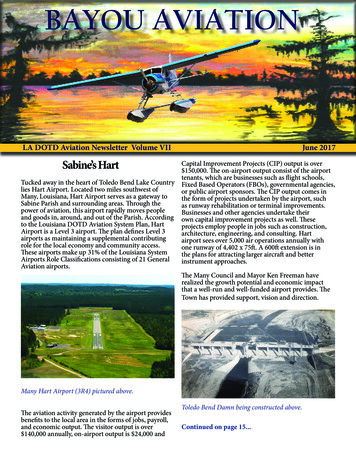
Transcription
BAYOU AVIATIONLA DOTD Aviation Newsletter Volume VIIJune 2017Sabine’s HartCapital Improvement Projects (CIP) output is over 150,000. The on-airport output consist of the airporttenants, which are businesses such as flight schools,Tucked away in the heart of Toledo Bend Lake Country Fixed Based Operators (FBOs), governmental agencies,lies Hart Airport. Located two miles southwest ofor public airport sponsors. The CIP output comes inMany, Louisiana, Hart Airport serves as a gateway tothe form of projects undertaken by the airport, suchSabine Parish and surrounding areas. Through theas runway rehabilitation or terminal improvements.power of aviation, this airport rapidly moves peopleBusinesses and other agencies undertake theirand goods in, around, and out of the Parish. According own capital improvement projects as well. Theseto the Louisiana DOTD Aviation System Plan, Hartprojects employ people in jobs such as construction,Airport is a Level 3 airport. The plan defines Level 3architecture, engineering, and consulting. Hartairports as maintaining a supplemental contributingairport sees over 5,000 air operations annually withrole for the local economy and community access.one runway of 4,402 x 75ft. A 600ft extension is inThese airports make up 31% of the Louisiana Systemthe plans for attracting larger aircraft and betterAirports Role Classifications consisting of 21 Generalinstrument approaches.Aviation airports.The Many Council and Mayor Ken Freeman haverealized the growth potential and economic impactthat a well-run and well-funded airport provides. TheTown has provided support, vision and direction.Many Hart Airport (3R4) pictured above.The aviation activity generated by the airport providesbenefits to the local area in the forms of jobs, payroll,and economic output. The visitor output is over 140,000 annually, on-airport output is 24,000 andToledo Bend Damn being constructed above.Continued on page 15.
Lakeysha BullockFrom the Director’s ChairLA DOTD Aviation InternBy: Bradley BrandtAir Service to the communities in our state is criticalto our local and state economies. The state’s airportsthat support commercial airline service are a criticalpart of Louisiana’s transportation network and havea significant impact on the state and local economies.These airports support over 49,000 jobs, with a payrollof nearly 1.4 billion and produces an economicimpact to our state of over 5.7 billion annually(Louisiana Airports Economic Impact Study, 2015).The impact analysis has shown the importance of ourcommercial airports and all the airlines that servethem. These airports provide critical links to thenational air transportation system by connecting yourcommunities to the world. More importantly, theyconnect the world to your communities. The benefits,health, welfare and quality of life that airports provideto your residents, businesses, and visitors is extremelyimportant to the future growth of the area in whichyou live.So, the next time you find yourself with a need to useair travel to get to your destination, have an importantbusiness meeting, or have family or loved ones visit,consider the drive, parking fees, traffic congestion,TSA wait times, wear and tear on your vehicle, fuelcosts, and most importantly YOUR TIME in choosinga departure airport. If you calculate that up, nowconsider the time you will save. Many times it ischeaper, more efficient and closer to home to fly outof your hometown airport in Louisiana instead oftraveling to an out-of-state airport. If you would likemore information on the airport system or on ourcommercial airports please visit our website at www.dotd.la.gov/aviation.Sincerely,2Lakeysha Bullock is a Winnsboro, LA native. She iscurrently working on a Bachelor’s Degree in AviationManagement from the University of Louisiana atMonroe (ULM). Her interest in Aviation developedas a Flight Attendant for Omni Air International,which specializes in transporting military men andwomen serving in the armed forces. She has visitedover forty-six different countries and countless cities.Currently, Lakeysha works as an Operations Specialistfor Monroe Regional Airport. She will be joining ourAviation Division to broaden her knowledge in airportplanning and government agencies. Upon completionof her internship she will resume classes at ULM andcontinue her career at Monroe Regional Airport.Aaliyah ReedLA DOTD AviationMass CommunicationsInternAaliyah D. Reed is a 22yr old Mass CommunicationsPublic Relations Senior from the small town ofOberlin, Louisiana. She attends Southern Universityand A&M College in Baton Rouge, LA. She enjoyscooking, playing with her pets, and spending time withher family. Aaliyah plans to attend law school uponher graduation in December 2017. This summer sheis interning with the Aviation Department as a masscommunications intern. She is writing for variousAviation publications as well as creating content forsocial media and our website.
Alec FieldsJohn McMullenChennault InternationalAirport Director ofMaintenanceJohn McMullen has joined Chennault InternationalAirport as its Director of Maintenance. A native ofSulphur, McMullen is a McNeese State Universityalumni, and he has been a state licensed commercialand residential contractor for 27 years.In 2015, he retired from Phillips 66 after 33 yearsof service in operations. McMullen is married toMelanie Johnson McMullen, and they have a son,John Cabot II, and a daughter, Laura.John MichenerAssistant ManagerLA/NM Airports DistrictOfficeJohn Michener is the new Assistant ADO Managerfor the Louisiana/New Mexico ADO. John currentlyserves as a member of the AIP Branch team inHeadquarters. Prior to this he was a ProgramManager in the Arkansas/Oklahoma AirportsDevelopment Office in the Southwest Region. Healso worked in the private sector for an engineeringfirm in Virginia Beach, VA, and in the public sectorfor the Utah Department of Transportation. Heholds a Bachelor’s and Master’s degree in CivilEngineering from Brigham Young Universitywith an emphasis in Transportation and TrafficEngineering. John, his three kids and his wife havelived in several different states but are excited tosettle back down in a nice mild climate like Texas.OperationsSpecialist MonroeRegional AirportAlec Fields is an Operations Specialist at MonroeRegional Airport. Alec is a recent graduate from theUniversity of Louisiana at Monroe (ULM), where hereceived a degree in Aviation Management. Upongraduation, Alec received the award of OutstandingGraduate in the College of Business and SocialSciences and the Outstanding Graduate in AviationAward. Alec was recognized as the top graduate inAviation for the year 2016-2017. During his time atULM, Alec joined Phi Beta Sigma Fraternity Inc.and was recognized on the Dean’s List five times andthe President’s list three times. Alec currently livesin Monroe, Louisiana where he intends to earn hisMaster’s Degree in Business Administration whilecontinuing to work at Monroe Regional Airport.Robert SligerDirector of OperationsMonroe RegionalAirportRobert Sliger is the Director of Operations at theMonroe Regional Airport. Prior to his current position,Robert spent four years in Airport Operations atFort Lauderdale Executive Airport in south Florida,the number three busiest General Aviation airportin the US, and a year working at the NatchitochesRegional Airport in NW Louisiana. A 2011 graduateof Louisiana Tech in Aviation Management, Robertis currently pursuing a Masters in Aviation ScienceBusiness concentration from Everglades Universityin Florida. He enjoys aviation photography and planespotting.Bryan RamosLA/NM AirportsDistrict OfficeBryan Ramos is from El Paso, TX. He graduated fromthe University of Texas at El Paso in August 2015 witha Bachelor of Science in Civil Engineering.3
Kevin DollioleDirector of AviationLouis Armstrong NewOrleans InternationalAirportThe New Orleans Aviation Board (NOAB)announced the appointment of Kevin Dolliole asthe permanent Director of Aviation, effective June26, 2017. Dolliole will replace Mark Reis, who wasappointed as the interim Director of Aviation lastDecember. Dolliole joins the NOAB after servingas Director of Airports at St. Louis LambertInternational Airport and Aviation Director atSan Antonio International Airport. Dolliole haspreviously served in several executive positions atLouis Armstrong New Orleans International Airport,including Acting Director of Aviation.The Louis Armstrong New Orleans InternationalAirport is in the midst of constructing a worldclass North Terminal, scheduled to be complete inFebruary 2019. The project is projected to createan estimated 13,000 direct construction jobs andgenerate a nearly 1 billion investment in the region.The 972,000 square-foot terminal will feature 35gates, a 2,190-car parking garage and a groundtransportation staging area.With over 40 years of combined experience inthe airline and airport industries, Dolliole bringstechnical proficiency and innovative approaches toworking with airlines, developing new air serviceand managing capital construction projects to LouisArmstrong New Orleans International Airport.Dolliole is also experienced in planning efforts foroperational, organizational and airport developmentinitiatives.Louis Armstrong New Orleans InternationalAirport (MSY) is the primary commercial airportin the State of Louisiana serving over 80 percentof all passengers flying into the state. ArmstrongInternational Airport is owned by the City ofNew Orleans. The New Orleans Aviation Board(NOAB), an unattached board of the City of NewOrleans, oversees the administration, operation, andmaintenance of Armstrong International. The Airporthas 15 airlines providing service to 57 non-stopdestinations, including six international destinations.A new, world-class terminal complex is currentlybeing constructed. The new North Terminal will becomplete by February 2019. For more information,please visit www.flymsy.com.4Grab Your PassportsBritish Airways began flying directflights from Louis Armstrong NewOrleans International Airport (MSY)to Heathrow Airport in Londonon March 27, 2017. The flights areconducted on the new Boeing 787Dreamliners. Flights will leaveLondon at 3 PM and arrive at MSYat 7:30 PM. Flights will leave MSYat 9:40 AM and arrive in London at12:00 PM the next day.Condor Airlines launched itsnew non-stop flight from LouisArmstrong International Airport(MSY) to Frankfurt, Germany onMay 3, 2017. The route is expectedto run seasonally from May to earlyOctober. The flights will utilizerefurbished planes and will offereconomy, premium, and businessclass seating. A hot meal andbreakfast will also be included in the11-hour flight ticket price.
Another type of cracking is called Block Cracking.You can identify Block Cracking by the large squaresor rectangles that usually are formed when all of thecracks run together. Block cracking usually formswhen the pavement mix was incorrect or if a poorasphalt binder was used.Inspector’s Report:“Just Say No to Crack”A third type of cracking is referred to as EdgeCracking. These are cracks in the pavement rightwhere you would expect them to be, the edge. Edgecracks are between one and two feet from the edgeof the pavement and can be caused by a number ofvariables, such as poor drainage. Keeping the edgeof your pavement clear to allow water to freely flowaway is ideal. Other causes of Edge Cracking can bedried out soil causing pavement shrinkage and evenvegetation.By: Robert Sehon & Jason BallAviation Safety & Compliance OfficersWe all know that crack is whack, but DOTD’sAviation Division is here is explain why this is thecase. We hope by reading this article you gain a betterknowledge of the types of cracking common torunway/taxiway pavement and what common causesof that failure can be. Cracks in your pavement cantell you many things about the condition of thesurface as well as the condition of the sub basematerial beneath your runway or taxiway. Somecracking is normal due to common foundationsettling so knowing the differences is key toidentifying problems early. Common settling cracksare typically small, hairline cracks. One of the firsttypes of cracking we see is Longitudinal Cracking.Longitudinal Cracking is cracking that runs parallelto the centerline and usually in pavement joints.These longitudinal cracks can be evidence of poorjoints, shrinking, etc and can be repaired bysealing the cracks with a crack sealant material. Thiscrack sealant material prevents water from finding itsway below your pavement and further deterioratingthe base underneath.The last type of cracking is Alligator Cracking.Alligator Cracks can start out as longitudinal cracksbut over time they become a collection of manycracks, enough to break up the pavement intonumerous small pieces resembling an alligator’s skin.This condition can be the result of overloading thepavement, poor drainage or both.On the 5010 report, the inspectors do our best toidentify which type of cracks we locate on yourairfield so you have a better understanding of whatmay be happening beneath the surface. As alwaysa professional engineer should review the area anddetermine the exact cause and remedy for yourspecific situation. During your inspection, we willidentify any cracks we locate but it is best for airportpersonnel to monitor and record any expansion ofcracks to ensure the pavement is always safe for use.Any cracks that become too large or large pieces thatdislodge will possibly require NOTAMs to be issuedand emergency repairs. Our inspectors can helpanswer as many questions as you may have regardingthe findings on your inspections and we encourageeveryone to ride along during the inspection so thatway the inspector can specifically point out any areaswhich may be of concern, but not yet a discrepancy.5
Catching Up: Pilots for PatientsBy: Blue Cross & Blue Shield ofLouisiana FoundationPhilip Thomas, President of Pilots for Patients, 2009 Angel Award HonoreeIn 2008, The Times-Picayune published a story on ascrappy new group called Pilots for Patients. The paperinterviewed Larry Lehmann, a New Orleans attorney,and his client, Philip Thomas of Monroe, about theirwork for Louisiana’s patients.The “Angel Flight” model connected (and stillconnects) licensed pilots who own small aircraft –many recreational hobbyists – with patients in need ofno-cost travel for out-of-town treatment.Some patients need urgent transportation for surgery,such as organ transplants when, suddenly, a neededdonor organ is available. Others are enduring a chronicdisease such as cancer and are receiving treatment faraway from home.Lehmann and Thomas – both pilots – had parted wayswith a national organization to focus exclusively onLouisiana patients. The two explained why focusing onhome was so important to them:“A lot of times people can’t get the care they need in thecity that they live in,” Lehmann said.He and Philip Thomas, a client and friend who lives inMonroe, were active in Angel Flight, a nationwide volunteer pilots’ organization. But it seemed to them thatthe national group was not giving Louisianians sufficient attention, so they started their own organization.“Louisiana being second from the bottom forhealthcare, we felt that there was a need to helppeople ”“(Patients) say, ‘Well, what’s the catch?’” Thomas said.“I’ll say, ‘There is no catch.’ They say, ‘How many timescan I do this?’ ‘As many times as you need to.’”At the time the article was published, Pilots for Patientshad flown 120 missions with 5 volunteer pilots. A yearlater, when the Blue Cross and Blue Shield of Louisiana6recognized Philip Thomas with The Angel Award forhis work flying children in need of care, the crew hadflown 300 missions.“That was a big moment for us,” says Thomas. “TheAngel Award was a real moment of momentum for us.It brought us a lot of attention to our cause and helpedus push towards where we are now.”Today, Pilots for Patients has 120 pilots who havevolunteered to fly over 3,000 missions. The 3,000thmission was flown by Florence Bethard of Coushatta.In its newsletter, Pilots for Patients publishes its Top10 pilots for the year. Thomas, still a volunteer and atireless advocate for the work of his fellow pilots, is onthat list. He’s proud of the organization’s accomplishments – but is quick to point out that recognition isn’tthe point.“We’ve flown the equivalent of 57 times around theequator. Our [pilots] have given almost 3 million inin-kind services. We challenge each other for friendlymotivation, but honestly this is a ministry focused onpeople. It’s an incredible gift to us to have the opportunity to serve people in need and connect them withcare, to keep them going.”In 2015, the Foundation awarded Pilots for Patients anAngels of Change grant in recognition of its continuedexcellence. The organization used the grant fundto successfully recruit more pilots and even furtheraccelerate Pilots of Patients’ growth.Of its total missions flown, Pilots for Patients hasflown nearly 300 children for diagnoses, treatment orsurgery. The organization is actively partnering withchildren’s hospitals to increase that number. With theorganization’s pilot retention rate, Thomas isn’t worriedabout the demand.“I think what keeps the pilots coming back is thatsense of relief you create for patients or parents. Thatthey can focus on treatment and getting better, to sitback and let us take care of getting them there – I thinkthat is huge for people.”Philip Thomas is just one of more than 170 individualswho have been recognized with the Angel Award overthe last 20 years. The Angel Award, one of the signature programs of the Blue Cross Foundation, recognizes everyday people doing extraordinary good forLouisiana’s children.’To learn more about Pilots for Patients, visit their website at www.pilotsforpatients.org. To learn more aboutthe Blue Cross Foundation, the Angel Award and howto nominate an outstanding individual, visit www.BCBSLAFoundation.org.
Louisiana Flight SchoolsReady to Meet DemandBy: Leigh Guidrylguidry@gannett.comLouisiana State University offers a minor in aerospaceengineering.It’s an attractive opportunity between the growth andpay. The Handbook puts median pay for airline pilotsat 75,000 or more in 2015.“It’ll provide jobs for the area and attract businessesnow that we’ll have a source of highly qualifiedgraduates to work for them,” Perez said.Louisiana Tech and the University of Louisiana atMonroe offer aviation degree programs. In Monroeyou can get a Bachelor of Science in aviation and aPost-Baccalaureate Certificate in Unmanned AircraftSystems (UAS) Management (i.e., drones).Photo Courtesy of Louisiana Tech Aviation DepartmentLouisiana schools have shifted focus to workforcedevelopment in recent years to fill gaps left by retireesor quickly growing industries. One unique gap they’relooking to fill is in the sky.The job market for airline pilots, copilots and flightengineers is expected to grow up to 9 percent,according to the U.S. Bureau of Labor StatisticsOccupational Outlook Handbook, and state colleges inNew Iberia, Monroe and Ruston are preparing to meetthat demand.“The industry is in need, especially for the oil field,”said Andre Perez, director of Primary Partnershipsand Special Programs at South Louisiana CommunityCollege.Oil and gas may be the go-to in Acadiana, but Perezsaid SLCC is preparing for an expected void in themarket as pilots in all industries retire.And it’s not the only one.“Our enrollment is at the highest it’s been in 15years (at 210 students),” said Jordan Lyons, endowedprofessor and chair of Louisiana Tech University’sDepartment of Professional Aviation. “That’s due toseveral reasons, but primarily due to the industrydemand for pilots being so high. Our graduateplacement rate the last eight years has been 100percent.”Growth also is expected in flight-related job sectorslike aircraft mechanics and service technicians, aprogram SLCC already off
the number three busiest General Aviation airport in the US, and a year working at the Natchitoches Regional Airport in NW Louisiana. A 2011 graduate of Louisiana Tech in Aviation Management, Robert is currently pursuing a Masters in Aviation Scienc
